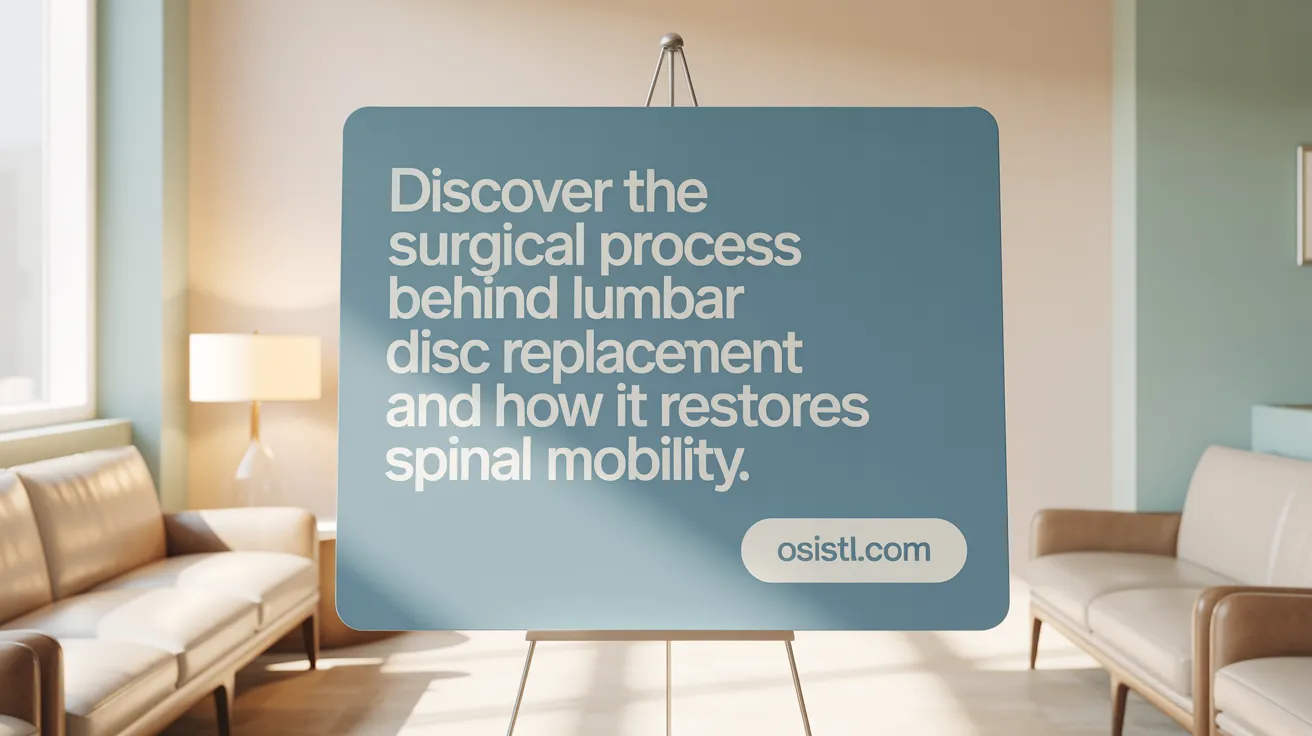Understanding Lumbar Disc Replacement Surgery
What is Lumbar Disc Replacement Surgery?
Lumbar disc replacement is a surgical procedure where a damaged or worn disc in the lower spine is removed and replaced with an artificial disc made from medical-grade materials such as metal and plastic. This surgery aims to relieve chronic low back pain and restore or maintain the natural movement and flexibility of the spine. Unlike traditional spinal fusion, which permanently joins vertebrae and restricts motion, disc replacement preserves spinal mobility.
Who is a Candidate?
Candidates typically suffer from chronic low back pain originating from one or two discs in the lumbar region. They often experience pain that worsens with bending or lifting, muscle spasms, or radiating pain down the hips or legs. Patients considered for this surgery usually have not responded to at least six months of non-surgical treatments like physical therapy. Ideal candidates have good spinal health without major deformities, nerve compression, or significant joint disease, and are generally non-obese and non-smokers.
How Does It Compare to Conservative Treatments?
Conservative care such as physical therapy and medication can improve symptoms for many patients. However, for those not finding relief, lumbar disc replacement offers a surgical option to address pain more effectively. While surgery often provides faster symptom relief compared to conservative approaches, long-term outcomes may be similar. The choice depends on symptom severity, impact on quality of life, and discussion with healthcare providers on treatment goals and options.
How Does Lumbar Disc Replacement Surgery Work?

What is lumbar disc replacement surgery and how is it performed?
Lumbar disc replacement surgery is a procedure designed to treat damaged or degenerated discs in the lower spine. It involves removing the faulty disc and replacing it with an artificial implant made from medical-grade metals such as titanium or cobalt-chromium combined with durable polyethylene plastic.
Surgical procedure overview
The surgery is performed under general anesthesia to ensure the patient is deeply asleep and pain-free. Surgeons make a small incision in the lower abdomen to access the lumbar spine. Through this anterior approach in lumbar disc replacement surgery, the damaged disc is carefully extracted. The vertebral bones adjacent to the disc space are prepared meticulously to receive the artificial disc. The prosthetic disc, designed to preserve the natural motion of the spine, is then implanted and fixed securely in place. Throughout the process, imaging such as fluoroscopy helps verify correct placement.
Artificial disc materials and design
The artificial discs are constructed to mimic the natural disc’s function, allowing bending and rotation while maintaining stability. Components often include metal plates with a polyethylene core designed to last for decades without significant wear. While current designs do not fully replicate natural disc shock absorption, ongoing innovation aims to improve this aspect in the future. For more details on the materials and design, see Artificial lumbar disk materials.
Surgical approach and hospital stay
Accessing the lumbar spine requires navigating important abdominal structures, making the surgery more complex than cervical disc replacement. Typically, patients stay in the hospital for one to a few days post-surgery for monitoring and early mobilization. Many patients begin walking soon after surgery and can expect to return to work within two to three weeks, depending on individual recovery, as described in Recovery time after lumbar disc replacement.
Who Are Ideal Candidates for Lumbar Disc Replacement?

Symptoms indicating surgery
Ideal candidates for lumbar disc replacement typically suffer from chronic low back pain linked to one or two degenerated lumbar discs. Their symptoms often include pain that intensifies with activities such as bending or lifting, along with muscle cramps or spasms. Many also report radiating pain extending into the hips, buttocks, or legs. These symptoms are usually persistent and have not significantly improved with at least six months of conservative treatment like physical therapy. See more on patient selection criteria for lumbar disc replacement.
Patient health considerations
Candidates should have good overall health, including adequate bone quality, and no significant spinal instability or deformity such as scoliosis. Those seeking this surgery generally do not have a history of previous extensive spinal surgery. Additionally, candidates should not be significantly overweight or suffer from osteoporosis, as these conditions may affect recovery and surgical success. A healthy lifestyle, including not smoking, helps reduce the risk of complications. For detailed criteria, consult patient selection criteria for lumbar disc replacement.
Contraindications for surgery
Certain conditions disqualify patients from lumbar disc replacement. These include ankylosing spondylitis, advanced facet joint degradation, spinal fractures, radiculopathy from nerve compression, spondylolisthesis, and other severe spinal deformities. Patients with extensive bone degeneration or multiple levels of disc problems may be better suited for alternative treatments such as spinal fusion. Thorough preoperative assessment ensures the selection of appropriate candidates to optimize outcomes. More information on risks and benefits of lumbar disc replacement.
Advantages of Lumbar Disc Replacement Over Spinal Fusion

What are the benefits of lumbar disc replacement compared to spinal fusion?
Lumbar disc replacement offers several significant advantages over spinal fusion, particularly in preserving natural spinal function and promoting quicker recovery.
Firstly, Lumbar Disc Replacement Surgery preserves the natural motion and flexibility of the spine. Unlike spinal fusion, which permanently joins vertebrae and restricts movement at the operated segment, Artificial Lumbar Disc replacement maintains bending and twisting capacities. This retention of spinal mobility helps reduce stress on adjacent discs and lowers the risk of adjacent segment disease—a common complication seen after fusion surgeries, as discussed in Artificial Disc Replacement Surgery Guide.
In terms of recovery, patients undergoing lumbar disc replacement often experience faster return to daily activities and work. Recovery Time after Lumbar Disc Replacement typically ranges from 2 to 6 weeks, considerably shorter than the longer healing period required for fusion due to the bone fusion process. Early mobilization is encouraged, with many patients walking soon after surgery and Hospital Stay after Surgery potentially limited to a day or two.
Patient satisfaction is generally higher after disc replacement, attributed to preserved motion and less postoperative pain. Long-term outcomes show durable implant performance, with Artificial Disc Longevity indicating artificial discs lasting decades while maintaining function. Moreover, lumbar disc replacement may reduce the need for further surgeries compared to fusion, providing a lasting solution with fewer complications, as noted in comparison of lumbar disc replacement and spinal fusion outcomes.
Overall, lumbar disc replacement stands out for its motion preservation, faster recovery, and improved quality of life, making it an attractive alternative for suitable candidates, especially those who wish to maintain active lifestyles. For details on candidate criteria, see patient selection criteria for lumbar disc replacement.
Potential Risks and Complications Associated with the Surgery

What risks and complications are associated with lumbar disc replacement surgery?
Lumbar disc replacement surgery is generally safe, but like all surgeries, it carries certain risks. Common surgical risks include reactions to anesthesia, bleeding, infection, nerve damage, and blood clots in the legs. These complications are relatively rare but important to consider. For more detailed information on Potential Complications of Surgery, you may refer to this resource.
Specific to the artificial disc implants, potential issues include dislocation or movement of the artificial disc from its proper position, implant failure or fracture, loosening or wear of the implant over time, and narrowing of the spinal canal (stenosis) due to implant-related changes. Improper implant placement and removal of key ligaments can lead to facet joint degradation, which is a frequent cause of implant failure. These risks are discussed extensively in the Risks and Challenges of Artificial Disc in the Low Back.
Although the artificial discs are designed to last for decades—sometimes up to 40 to 70 years—long-term concerns remain. Continued monitoring is crucial because wear debris from the implant or facet joint problems can develop over time. Revision surgeries may be necessary if complications arise. The Long-term Durability of Artificial Discs and Long-term outcomes of lumbar total disc replacement provide more details on such outcomes.
In summary, while lumbar disc replacement preserves spinal mobility and offers pain relief, patients should be aware of both the typical surgical risks and implant-specific complications. Engaging with an experienced surgical team and thorough preoperative assessment can help minimize these risks. See resources on Surgeon Expertise in Spine Procedures and Preparation for Lumbar Disc Replacement for further guidance.
Comparing Longevity and Outcomes: Disc Replacement Versus Other Spine Surgeries
How do outcomes and longevity of lumbar disc replacement compare with other spine surgeries?
Lumbar disc replacement (LDR) offers notable long-term improvements in pain relief and functional outcomes that are comparable to other common spinal surgeries such as spinal fusion and microdiscectomy. Success rates for LDR hover around 63.5%, while lumbar microdiscectomy and other traditional surgical methods report approximately 79% good to excellent outcomes over multiple years of follow-up (Long-term results of lumbar disc herniation surgeries).
The longevity of artificial lumbar discs is promising, with expected durability ranging from 40 to 70 years, far surpassing many other surgical implants (Artificial Disc Longevity, Long-term durability of artificial discs). This durability is an important benefit as it reduces the likelihood of early implant failure and need for revision surgeries.
Regarding reoperation frequency, patients undergoing LDR may face revision surgery, often converting to spinal fusion, but these rates mirror those seen in other joint replacements like hips and knees (Lumbar artificial disc replacement overview). Importantly, individuals who have had prior spine surgeries, including discectomy, do not necessarily experience worse outcomes with LDR, making it a viable option even after previous interventions (Impact of previous lumbar surgery on TDR outcomes).
In contrast, microdiscectomy tends to have lower rates of motion preservation since it focuses on disc removal without replacement, and spinal fusion permanently immobilizes treated vertebrae, which can lead to adjacent segment degeneration requiring further surgery (spinal fusion drawbacks, Adjacent segment disease and ADR. LDR's preservation of spinal mobility may contribute to an improved quality of life and reduced long-term complications (Preserving Spinal Mobility, Maintaining spinal mobility with ADR.
Overall, lumbar disc replacement stands out for its balance between sustained pain relief, motion preservation, and implant durability, with a reoperation profile consistent with other major joint surgeries (Artificial disc surgery, Reoperation rates after lumbar spine surgery).
Recovery Process and Postoperative Care After Lumbar Disc Replacement
Hospital Stay and Early Mobilization
After lumbar disc replacement surgery, patients typically stay in the hospital for one or a few nights. Early mobilization is encouraged, with patients often standing and walking within the first day following surgery. This early activity helps promote circulation, reduces risks of blood clots, and aids overall recovery (Postoperative care for lumbar disk replacement, Potential Complications of Surgery).
Physical Therapy and Activity Guidelines
Physical therapy plays a crucial role in postoperative care, focusing on exercises that maintain spinal flexibility and strengthen muscles supporting the spine. Patients are advised on careful movement techniques to protect the surgical site while gradually increasing activity levels. Avoiding heavy lifting and bending initially is important to ensure proper healing (Recovery time after lumbar disk replacement, Physical therapy after disk replacement).
Timeline for Return to Work
Most patients can expect to return to light work and daily activities within 2 to 6 weeks, depending on their individual health and job demands. Recovery times can vary, but minimally invasive surgery combined with physical therapy often results in quicker resumption of normal activities (Recovery times for disc replacement). Patients are also guided on lifestyle modifications such as quitting smoking and maintaining a healthy weight to support long-term spine health (Lifestyle advice after lumbar disk replacement.
Postoperative care also involves monitoring the surgical incision for signs of infection, managing pain effectively, and attending follow-up evaluations with the healthcare team to track progress and address any complications early (Incision care and complication signs, Potential Complications of Surgery.
Challenges and Limitations of Lumbar Disc Replacement Surgery
What challenges limit the broader adoption of lumbar disc replacement surgery?
Lumbar disc replacement (LDR) surgery faces several hurdles that limit its broader adoption despite its potential benefits. One major challenge is the surgical complexity. The procedure requires an anterior approach in lumbar disc replacement surgery, which demands careful navigation around organs and blood vessels—making it more technically demanding than cervical disc replacement surgeries (The Risks and Challenges of Artificial Disc in the Low Back).
Moreover, strict patient selection criteria for lumbar disc replacement restrict eligibility. Ideal candidates must be relatively young, non-obese, without significant facet joint degradation, osteoporosis, or spinal deformities. Improper implant positioning or removal of supporting ligaments can lead to complications such as facet joint degeneration, which is a frequent cause of failure (Complications of lumbar artificial disc replacement.
Insurance and reimbursement issues also play a significant role. Many insurers deny coverage for LDR, limiting patients' access despite evidence suggesting it can be less costly than lumbar fusion due to shorter hospital stays and operative times (Costs of Lumbar Disc Replacement.
These factors have contributed to a steep decline—about 85%—in lumbar disc replacement surgeries from 2005 to 2017 (Lumbar artificial disc replacement overview. While LDR preserves spinal motion and may reduce adjacent segment disease risk (Spinal fusion drawbacks, these challenges currently hinder its widespread use.
Continuous advances in Lumbar Disc Replacement Surgery, alongside efforts to address coverage barriers, may improve accessibility and outcomes in the future.
Emerging Advances and Future Directions in Lumbar Disc Replacement

What are the future trends and innovations in lumbar disc replacement surgery?
Lumbar disc replacement is evolving rapidly with several promising developments on the horizon. Technological innovations focus on creating artificial discs that better mimic the natural shock absorption feature of healthy spinal discs, which current implants partly lack. These improved designs aim to reduce wear and extend implant longevity while preserving natural spinal motion (Artificial Lumbar Disc, Artificial Disc Replacement Benefits, The Risks and Challenges of Artificial Disc in the Low Back.
Robotic-assisted surgery is poised to become a valuable tool for lumbar disc replacement. By enhancing surgical precision and allowing minimally invasive approaches, robotic technology can reduce tissue disruption and complications, potentially speeding recovery and improving outcomes (Robotic Assistance in Spine Surgery, Minimally Invasive Spine Procedures.
Additionally, future directions emphasize enhanced patient education, enabling individuals to make informed choices tailored to their specific spine conditions. Surgeons will likely employ advanced imaging and diagnostic tools to select optimal candidates and plan personalized procedures (patient selection criteria for lumbar disc replacement, Preoperative Assessments for ADR.
Together, these innovations aim to lower complication rates, improve implant durability, and optimize postoperative recovery. They may help overcome some limitations of current lumbar disc replacement methods, increasing the procedure's popularity as a treatment for disc-related back pain and degeneration (Benefits of Lumbar Disc Replacement, Artificial Disc Longevity, Recovery Time after Lumbar Disc Replacement.
Balancing Surgical Options: Lumbar Disc Replacement in Clinical Decision-Making
How do surgeons determine whether lumbar disc replacement or fusion is the better option?
Surgeons select between lumbar disc replacement (LDR) and spinal fusion by carefully evaluating patient-specific factors. Ideal candidates for LDR typically have limited disc disease affecting one or two lumbar discs, good bone quality, absence of spinal deformities like scoliosis, and no significant spinal instability. These patients often seek to maintain spinal motion and prefer a quicker recovery. In contrast, spinal fusion is usually favored when patients have spinal instability, multi-level disc problems, degenerative joint disease, or significant deformities where eliminating movement in the painful segment can provide better relief (patient selection criteria for lumbar disc replacement.
Comparative clinical indications
-
Lumbar Disc Replacement: Best suited for younger, non-obese patients without severe facet joint degeneration or prior extensive spine surgeries. Candidates commonly experience discogenic back pain localized to a few discs and have failed at least six months of conservative care (Candidates for Lumbar Disc Replacement.
-
Spinal Fusion: Recommended for patients with degenerative changes affecting multiple spinal segments, spinal deformities, previous failed surgeries, or instability. Fusion can address complex biomechanical problems but results in loss of movement at fused segments (Lumbar Fusion Surgery).
Suitability of fusion vs replacement
Disc replacement preserves spinal mobility, potentially reducing adjacent segment disease risk and enabling faster recovery (often within 2-6 weeks) (Surgery vs Spinal Fusion. Fusion offers long-lasting stability and pain relief but at the cost of spinal flexibility and typically a longer recovery period. Both procedures achieve comparable pain relief, yet patient satisfaction often tends to be higher following disc replacement (Artificial Disc Replacement Surgery Guide.
Importance of surgeon expertise
Successful outcomes rely significantly on the surgeon’s experience and understanding of proper patient selection and surgical technique. Lumbar disc replacement requires precise implant placement and careful management of anatomical challenges, particularly via the anterior approach in lumbar disc replacement surgery. Surgeons well-versed in both approaches can tailor recommendations balancing benefits, risks, and patient goals.
Selecting the appropriate surgical intervention requires a personalized approach encompassing clinical assessment, imaging studies, patient health, and lifestyle considerations, ensuring optimal functional outcomes and quality of life (clinical considerations for spinal surgery.
Making an Informed Choice About Lumbar Disc Replacement
Benefits and Risks of Lumbar Disc Replacement
Lumbar disc replacement is a surgical procedure designed to alleviate chronic back pain by replacing a damaged spinal disc with an artificial one. It preserves spinal mobility, which sets it apart from fusion surgery that limits motion. Patients often experience significant pain relief, quicker recovery times, and improved quality of life post-surgery. However, there are risks such as infection, nerve injury, implant dislocation, and the possibility of needing revision surgery. Modern artificial discs are built to last decades, but long-term monitoring is essential.
Patient Factors and Surgeon Guidance
Choosing lumbar disc replacement depends on several individual factors. Ideal candidates are generally healthy adults with pain localized to one or two lumbar discs, no major joint disease, or spinal deformities. Those who have not responded to conservative care over six months may consider surgery. Surgeon expertise and thorough preoperative assessments—including imaging and physical exams—play a crucial role in determining suitability and managing potential complications.
Personalized Treatment Planning
Personalized care is essential when deciding on lumbar disc replacement. Patients should discuss their full medical history, lifestyle, and treatment goals with their surgeon. Collaborative planning ensures the selected procedure aligns with patient needs while considering the pros and cons of alternatives like spinal fusion. This approach helps optimize outcomes and ensures a well-informed decision for long-term spinal health.
